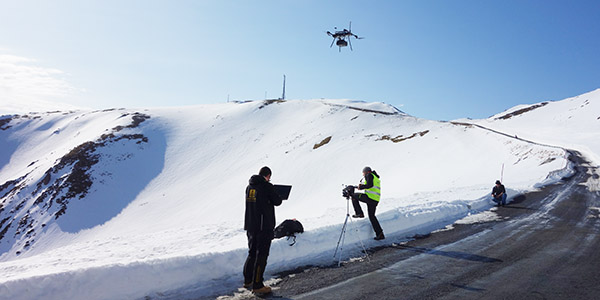Can unmanned aircraft systems (UAS) support the Norwegian Public Roads Administration’s (NPRA) mission to monitor snow avalanche hazards above their roads?
NPRA staff recognized that UASs (often called drones) could reduce the need for avalanche staff to travel to dangerous avalanche zones and could provide high quality information to support their risk assessments. In an effort to explore UAS technology, the NPRA sponsored a test in March 2016 where Norwegian UAS vendors were invited to demonstrate their aircraft’s ability to fly in steep mountains in cold and windy winter conditions (http://nordicroads.com/unmanned-aircraft-for-roadside-avalanche-monitoring/). The test confirmed that UASs could be setup to operate next to roads and fly in the typical weather where the NPRA conducts avalanche evaluations but also showed that camera quality and sensor technology are critical to their usefulness. These findings prompted a follow-on two day field test in April 2018 in Andøya, Norway where the NPRA evaluated the usability of sensors and cameras on UAS.
The test
The Andøya test, working with the Northern Research Institute and Romvesen, evaluated ground penetrating radar (GPR), photogrammetry (structure from motion or SfM), and digital cameras flown on small multi-rotor UASs. The test assessed these devices’ ability to provide useful information for avalanche risk assessment including snow pack composition and depth, the characteristics of the snow surface, and surveillance of the surrounding terrain. Using both a buried volunteer and a derelict vehicle covered by a mound of snow, the GPR sensors were also tested for their ability to detect objects under the snow. This application of GPR could be valuable in the case of an accidental avalanche burial.
All of the twenty flights during the test were coordinated by the Andøya Space Center in a controlled test areas close to the town of Andenes in northern Norway. The data from the sensors were compared to snow conditions as determined by a series of evaluation pits hand dug by NPRA avalanche experts. The usability of the UAS’s cameras were evaluated on flights above an avalanche remnant on a nearby mountain.

Detecting avalanche conditions using ground penetrating radar on a small unmanned aircraft. Photo: Torgeir Vaa
The Findings
The test demonstrated that GPR output could, under an aircraft’s flight path, remotely identify weak layers important for snow avalanche hazard monitoring. However, the raw GPR output was a challenge for non-experts to interpret and required post-processing to be most useful to the NPRA. The project team felt that GPR technology will need further development to allow avalanche staff to quickly use raw sensor output to find hazardous conditions in the snow pack. This may require software to interpret GPR output in real time as the aircraft are flow above avalanche risk areas. Both organizations supplying the GPR for this test indicated that they now have a better idea of NPRA’s need and will build more usable systems. The GPR was also able to identify buried vehicles and humans which has value for safety but again this output worked best with post-processing.
Digital cameras on UAS were used to view surface features of the snow and this visual output was immediately usable to the NPRA’s avalanche experts. The use of structure from motion software on photographs derived from lower cost digital cameras could potentially map snow surface conditions and measure snow depth, both of which are valuable for avalanche hazard assessment. SfM used both before and after a snow fall could provide valuable data about snow pack depths and snow volumes. Since SfM can be used on small UASs already owned by the NPRA, the research team recommended that the NPRA further explore this technology.
Authors:
Edward McCormack, Norwegian University of Science and Technology
Torgeir Vaa, Norwegian Public Roads Administration
Gunne Håland, Norwegian Public Roads Administration
Tore Humstad, Norwegians Public Roads Administration

Contact:
Edward McCormack, Professor
edm@uw.edu
Norwegian University of Science and Technology






Follow us: